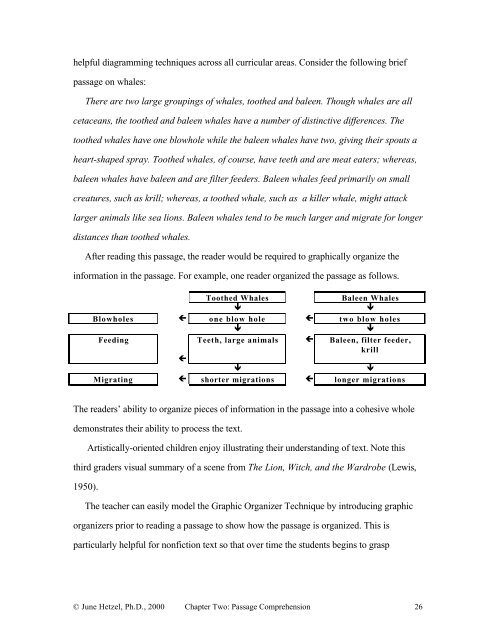Reading in the Elementary Classroom Chapter Two: Passage ...
Reading in the Elementary Classroom Chapter Two: Passage ...
Reading in the Elementary Classroom Chapter Two: Passage ...
Create successful ePaper yourself
Turn your PDF publications into a flip-book with our unique Google optimized e-Paper software.
helpful diagramm<strong>in</strong>g techniques across all curricular areas. Consider <strong>the</strong> follow<strong>in</strong>g brief<br />
passage on whales:<br />
There are two large group<strong>in</strong>gs of whales, too<strong>the</strong>d and baleen. Though whales are all<br />
cetaceans, <strong>the</strong> too<strong>the</strong>d and baleen whales have a number of dist<strong>in</strong>ctive differences. The<br />
too<strong>the</strong>d whales have one blowhole while <strong>the</strong> baleen whales have two, giv<strong>in</strong>g <strong>the</strong>ir spouts a<br />
heart-shaped spray. Too<strong>the</strong>d whales, of course, have teeth and are meat eaters; whereas,<br />
baleen whales have baleen and are filter feeders. Baleen whales feed primarily on small<br />
creatures, such as krill; whereas, a too<strong>the</strong>d whale, such as a killer whale, might attack<br />
larger animals like sea lions. Baleen whales tend to be much larger and migrate for longer<br />
distances than too<strong>the</strong>d whales.<br />
After read<strong>in</strong>g this passage, <strong>the</strong> reader would be required to graphically organize <strong>the</strong><br />
<strong>in</strong>formation <strong>in</strong> <strong>the</strong> passage. For example, one reader organized <strong>the</strong> passage as follows.<br />
Too<strong>the</strong>d Whales Baleen Whales<br />
<br />
Blowholes one blow hole two blow holes<br />
<br />
Feed<strong>in</strong>g Teeth, large animals Baleen, filter feeder,<br />
krill<br />
<br />
Migrat<strong>in</strong>g shorter migrations longer migrations<br />
The readers’ ability to organize pieces of <strong>in</strong>formation <strong>in</strong> <strong>the</strong> passage <strong>in</strong>to a cohesive whole<br />
demonstrates <strong>the</strong>ir ability to process <strong>the</strong> text.<br />
Artistically-oriented children enjoy illustrat<strong>in</strong>g <strong>the</strong>ir understand<strong>in</strong>g of text. Note this<br />
third graders visual summary of a scene from The Lion, Witch, and <strong>the</strong> Wardrobe (Lewis,<br />
1950).<br />
The teacher can easily model <strong>the</strong> Graphic Organizer Technique by <strong>in</strong>troduc<strong>in</strong>g graphic<br />
organizers prior to read<strong>in</strong>g a passage to show how <strong>the</strong> passage is organized. This is<br />
particularly helpful for nonfiction text so that over time <strong>the</strong> students beg<strong>in</strong>s to grasp<br />
© June Hetzel, Ph.D., 2000 <strong>Chapter</strong> <strong>Two</strong>: <strong>Passage</strong> Comprehension 26


